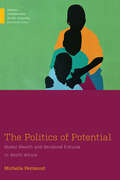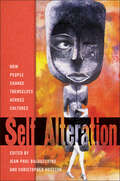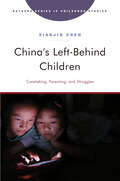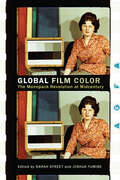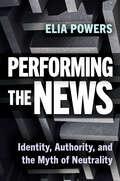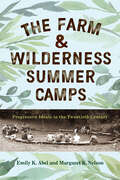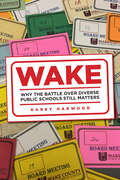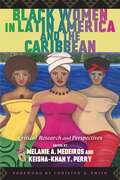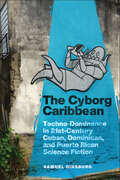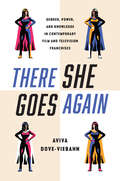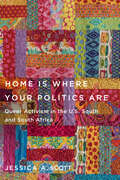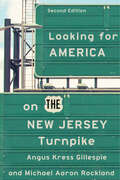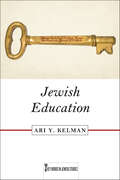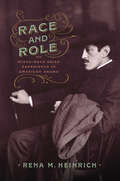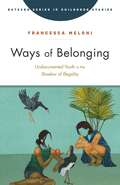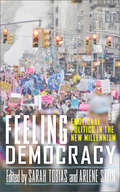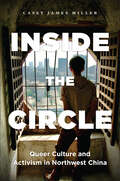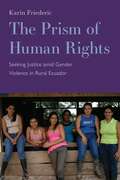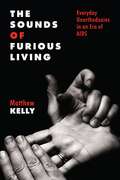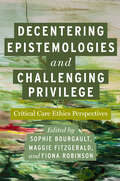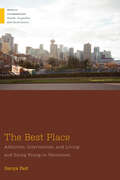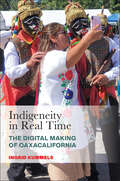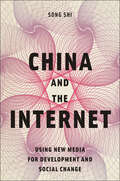- Table View
- List View
The Politics of Potential: Global Health and Gendered Futures in South Africa (Medical Anthropology)
by Michelle PentecostThe first one thousand days of human life, or the period between conception and age two, is one of the most pivotal periods of human development. Optimizing nutrition during this time not only prevents childhood malnutrition but also determines future health and potential. The Politics of Potential examines early life interventions in the first one thousand days of life in South Africa, drawing on fieldwork from international conferences, government offices, health-care facilities, and the everyday lives of fifteen women and their families in Cape Town. Michelle Pentecost explores various aspects of a politics of potential, a term that underlines the first one thousand days concept and its effects on clinical care and the lives of childbearing women in South Africa. Why was the First One Thousand Days project so readily adopted by South Africa and many other countries? Pentecost not only explores this question but also discusses the science of intergenerational transmissions of health, disease, and human capital and how this constitutes new forms of intergenerational responsibility. The women who are the target of first one thousdand days interventions are cast as both vulnerable and responsible for the health of future generations, such that, despite its history, intergenerational responsibility in South Africa remains entrenched in powerfully gendered and racialized ways.
Self-Alteration: How People Change Themselves across Cultures
by Michael Jackson Kathryn Rountree Nigel Rapport Banu Senay Max Harwood Gil Hizi Muhammad Kavesh Gisella Orsini Jaap TimmerMany of us feel a pressing desire to be different—to be other than who we are. Self-conscious, we anxiously perceive our shortcomings or insufficiencies, wondering why we are how we are and whether we might be different. Often, we wish to alter ourselves, to change our relationships, and to transform the person we are in those relationships. Not only a philosophical question about how other people change, self-alteration is also a practical care—can I change, and how? Self-Alteration: How People Change Themselves across Cultures explores and analyzes these apparently universal hopes and their related existential dilemmas. The essays here come at the subject of the self and its becoming through case studies of modes of transformation of the self. They do this with social processes and projects that reveal how the self acquires a non-trivial new meaning in and through its very process of alteration. By focusing on ways we are allowed to change ourselves, including through religious and spiritual traditions and innovations, embodied participation in therapeutic programs like psychoanalysis and gendered care services, and political activism or relationships with animals, the authors in this volume create a model for cross-cultural or global analysis of social-self change that leads to fresh ways of addressing the 'self' itself.
China's Left-Behind Children: Caretaking, Parenting, and Struggles (Rutgers Series in Childhood Studies)
by Xiaojin ChenOne unintended consequence of the unprecedented rural-to-urban migration in China over the past three decades is the exponentially increased number of "left-behind" children—children whose parents migrated to more developed areas and who live with one parent or other extended family members. The daily lives of these children, including their caretaking arrangements, parent-child bonding and communication, and schooling, are fraught with distractions and uncertainties. Paying special attention to this marginalized group, this book investigates the role of parental migration and the left-behind status in shaping Chinese family dynamics and children’s general wellbeing, including their school performance, delinquency, resilience, feelings of ambiguous loss, and other psychological problems. Blending theory, empirical research, and real-world interviews with left-behind children, China's Left-Behind Children provides a uniquely close look at these children's lives while also providing the larger national context that defines and shapes their everyday lives.
Global Film Color: The Monopack Revolution at Midcentury
by William Carroll Joshua Yumibe Philip Cavendish Kathryn Millard Sarah Street Laura Major Ranjani Mazumdar Stefan Soloman Kirsty Sinclair Dootson Kamalika Sanyal Heather Heckman Lydia Pappas Elena Gipponi Rafael de Luna Freire Josephine Diecke Linda Chen ZhangGlobal Film Color: The Monopack Revolution at Midcentury explores color filmmaking in a variety of countries and regions including India, China, Japan, and Russia, and across Europe and Africa. Most previous accounts of color film have concentrated on early 20th century color processes and Technicolor. Far less is known about the introduction and application of color technologies in the period from the mid-1940s to the 1980s, when photochemical, “monopack” color stocks came to dominate global film markets. As Eastmancolor, Agfacolor, Fujicolor and other film stocks became broadly available and affordable, national film industries increasingly converted to color, transforming the look and feel of global cinema. Covering a broad range of perspectives, the chapters explore themes such as transnational flows, knowledge exchange and transfer, the cyclical and asymmetrical circulation of technology in a global context, as well as the accompanying transformation of color film aesthetics in the postwar decades.
Performing the News: Identity, Authority, and the Myth of Neutrality
by Elia PowersPerforming the News: Identity, Authority, and the Myth of Neutrality explores how journalists from historically marginalized groups have long felt pressure to conform when performing for audiences. Many speak with a flat, “neutral” accent, modify their delivery to hide distinctive vocal attributes, dress conventionally to appeal to the “average” viewer, and maintain a consistent appearance to avoid unwanted attention. Their aim is what author Elia Powers refers to as performance neutrality—presentation that is deemed unobjectionable, reveals little about journalists’ social identity, and supposedly does not detract from their message. Increasingly, journalists are challenging restrictive, purportedly neutral forms of self-presentation. This book argues that performance neutrality is a myth that reinforces the status quo, limits on-air diversity, and hinders efforts to make newsrooms more inclusive. Through in-depth interviews with journalists in broadcasting and podcasting, and those who shape their performance, the author suggests ways to make journalism more inclusive and representative of diverse audiences.
The Farm & Wilderness Summer Camps: Progressive Ideals in the Twentieth Century
by Emily K. Abel Margaret K. NelsonAlthough summer camps profoundly impact children, they have received little attention from scholars. The well-known Farm & Wilderness (F&W) camps, founded in 1939 by Ken and Susan Webb, resembled most other private camps of the same period in many ways, but F&W also had some distinctive features. Campers and staff took pride in the special ruggedness of the surrounding environment, and delighted in the exceptional rigor of the camping trips and the work projects. Importantly, the Farm & Wilderness camps were some of the first private camps to become racially integrated.The Farm & Wilderness Summer Camps: Progressive Ideals in the Twentieth Century traces these camps, both unique and emblematic of American youth culture of the twentieth century, from their establishment in the late 1930s to the end of the twentieth century. Emily K. Abel and Margaret K. Nelson explore how ideals considered progressive in the 1940s and 1950s had to be reconfigured by the camps to respond to shifts in culture and society as well as to new understandings of race and ethnicity, social class, gender, and sexual identity. To illustrate this change, the authors draw on over forty interviews with former campers, archival materials, and their own memories. This book tells a story of progressive ideals, crises of leadership, childhood challenges, and social adaptation in the quintessential American summer camp.
Wake: Why the Battle over Diverse Public Schools Still Matters (Critical Issues in American Education)
by Karey Alison HarwoodThe Wake County Public School System was once described as a beacon of hope for American school districts. It was both academically successful and successfully integrated. It accomplished these goals through the hard work of teachers and administrators, and through a student assignment policy that made sure no school in the countywide district became a high poverty school. Although most students attended their closest school, the “diversity policy” modified where some students were assigned to make sure no school had more than 40% of its students qualifying for free or reduced-price lunch or more than 25% performing below grade level. When the school board election of 2009 swept into office a majority who favored “neighborhood schools,” the diversity policy that had governed student assignment for years was eliminated. Wake: Why the Battle Over Diverse Public Schools Still Matters tells the story of the aftermath of that election, including the fierce public debate that ensued during school board meetings and in the pages of the local newspaper, and the groundswell of community support that voted in a pro-diversity school board in 2011. What was at stake in those years was the fundamental direction of the largest school district in North Carolina and the 14th largest in the U.S. Would it maintain a commitment to diverse schools, and if so, how would it balance that commitment with various competing interests and demands? Through hundreds of published opinion articles and several in depth interviews with community leaders, Wake examines the substance of that debate and explores the community’s vision for public education. Wake also explores the importance of knowing the history of a place, including the history of school segregation. Wake County’s example still resonates, and the battle over diverse public schools still matters, because owning responsibility for the problem of segregated schools (or not) will shape the direction of America’s future.
Black Women in Latin America and the Caribbean: Critical Research and Perspectives
by Julia S. Abdalla Angela Crumdy Bruna Cristina Pereira Ishan Gordon-Ugarte Castriela E. Hernández Reyes Eshe E. Lewis Cristiano Dos Rodrigues Edilza Correia Sotero Maziki Thame Melanie WhiteBlack Women in Latin America and the Caribbean: Critical Research and Perspectives employs an intersectional and interdisciplinary approach to examine Black cisgender women’s social, cultural, economic, and political experiences in Latin America and the Caribbean. It presents critical empirical research emphasizing Black women’s innovative, theoretical, and methodological approaches to activism and class-based gendered racism and Black politics. While there are a few single-authored books focused on Black women in Latin American and Caribbean, the vast majority of the scholarship on Black women in Latin America and the Caribbean has been published as theses, dissertations, articles, and book chapters. This volume situates these social and political analyses as interrelated and dialogic and contributes a transnational perspective to contemporary conversations surrounding the continued relevance of Black women as a category of social science inquiry. Many of the contributing authors are from Latin American and Caribbean countries, reflecting a commitment to representing the valuable observations and lived experiences of scholars from this region. When read together, the chapters offer a hemispheric framework for understanding the lasting legacies of colonialism, transatlantic slavery, plantation life, and persistent socio-economic and cultural violence.
The Cyborg Caribbean: Techno-Dominance in Twenty-First-Century Cuban, Dominican, and Puerto Rican Science Fiction (Critical Caribbean Studies)
by Samuel GinsburgThe Cyborg Caribbean examines a wide range of twenty-first-century Cuban, Dominican, and Puerto Rican science fiction texts, arguing that authors from Pedro Cabiya, Alexandra Pagan-Velez, and Vagabond Beaumont to Yasmin Silvia Portales, Erick Mota, and Yoss, Haris Durrani, and Rita Indiana Hernandez, among others, negotiate rhetorical legacies of historical techno-colonialism and techno-authoritarianism. The authors span the Hispanic Caribbean and their respective diasporas, reflecting how science fiction as a genre has the ability to manipulate political borders. As both a literary and historical study, the book traces four different technologies—electroconvulsive therapy, nuclear weapons, space exploration, and digital avatars—that have transformed understandings of corporality and humanity in the Caribbean. By recognizing the ways that increased technology may amplify the marginalization of bodies based on race, gender, sexuality, and other factors, the science fiction texts studied in this book challenge oppressive narratives that link technological and sociopolitical progress. .
There She Goes Again: Gender, Power, and Knowledge in Contemporary Film and Television Franchises
by Aviva Dove-ViebahnThere She Goes Again interrogates the representation of ostensibly powerful women in transmedia franchises, examining how presumed feminine traits—love, empathy, altruism, diplomacy—are alternately lauded and repudiated as possibilities for effecting long-lasting social change. By questioning how these franchises reimagine their protagonists over time, the book reflects on the role that gendered exceptionalism plays in social and political action, as well as what forms of knowledge and power are presumed distinctly feminine. The franchises explored in this book illustrate the ambivalent (post)feminist representation of women protagonists as uniquely gifted in ways both gendered and seemingly ungendered, and yet inherently bound to expressions of their femininity. At heart,There She Goes Again asks under what terms and in what contexts women protagonists are imagined, envisioned, embodied, and replicated in media. Especially now, in a period of gradually increasing representation, women protagonists demonstrate the importance of considering how we should define—and whether we need—feminine forms of knowledge and power.
Home Is Where Your Politics Are: Queer Activism in the U.S. South and South Africa
by Jessica A. ScottHome Is Where Your Politics Are is a transnational consideration of queer and trans activism in the US South and South Africa. Through ethnographic exploration of queer and trans activist work in both places, Jessica Scott paints a vibrant picture of what life is like in relation to a narrative that says that queer life is harder, if not impossible, in rural areas and on the African continent. The book asks questions like, what do activists in these places care about and how do stories about where they live get in the way of the life they envision for the queer and trans people for whom they advocate? Answers to these questions provide insight that only these activists have, into the complexity of locally based advocacy strategies in a globalized world.
Polish Jewish Culture Beyond the Capital: Centering the Periphery
by Zehavit Stern Ela Bauer Naomi Seidman Daniel Kupfert Heller Marcos Silber Justin Cammy Eugenia Prokop-Janiec Bozena Shallcross Malgorzata Stolarska-Fronia Magdalena Kozlowska Sylwia Jakubczyk-Sleczka Alicja Maslak-MaciejewskaPolish Jewish Culture beyond the Capital: Centering the Periphery is a path-breaking exploration of the diversity and vitality of urban Jewish identity and culture in Polish lands from the second half of the nineteenth century to the outbreak of the Second World War (1899–1939). In this multidisciplinary essay collection, a cohort of international scholars provides an integrated history of the arts and humanities in Poland by illuminating the complex roles Jews in urban centers other than Warsaw played in the creation of Polish and Polish Jewish culture. Each essay presents readers with the extraordinary production and consumption of culture by Polish Jews in literature, film, cabaret, theater, the visual arts, architecture, and music. They show how this process was defined by a reciprocal cultural exchange that flourished between cities at the periphery—from Lwów and Wilno to Kraków and Łódź—and international centers like Warsaw, thereby illuminating the place of Polish Jews within urban European cultures. Companion website (https://polishjewishmusic.iu.edu)
Looking for America on the New Jersey Turnpike, Second Edition
by Michael Aaron Rockland Angus Kress GillespieA twelve-lane behemoth cutting through the least scenic parts of the Garden State, the New Jersey Turnpike may lack the romantic allure of highways like Route 66, but it might just be a more accurate symbol of American life, representing the nation at both its best and its worst. When Angus Gillespie and Michael Rockland wrote Looking for America on the New Jersey Turnpike in 1989, they simply wanted to express their fascination with a road that many commuters regarded with annoyance or indifference. Little did they expect that it would be hailed as a classic, listed by the state library alongside works by Whitman and Fitzgerald as one of the ten best books ever written about New Jersey or by a New Jerseyan. Now Looking for America on the New Jersey Turnpike is back in a special updated and expanded edition, examining how this great American motorway has changed over the past thirty-five years. You’ll learn how the turnpike has become an icon inspiring singers and poets. And you’ll meet the many people it has affected, including the homeowners displaced by its construction, the highway patrol and toll-takers who work on it, and the drivers who speed down its lanes every day.
Jewish Education (Key Words in Jewish Studies)
by Ari Y KelmanMost writing about Jewish education has been preoccupied with two questions: What ought to be taught? And what is the best way to teach it? Ari Y Kelman upends these conventional approaches by asking a different question: How do people learn to engage in Jewish life? This book, by centering learning, provides an innovative way of approaching the questions that are central to Jewish education specifically and to religious education more generally. At the heart of Jewish Education is an innovative alphabetical primer of Jewish educational values, qualities, frameworks, catalysts, and technologies which explore the historical ways in which Jewish communities have produced and transmitted knowledge. The book examines the tension between Jewish education and Jewish Studies to argue that shifting the locus of inquiry from “what people ought to know” to “how do people learn” can provide an understanding of Jewish education that both draws on historical precedent and points to the future of Jewish knowledge.
Race and Role: The Mixed-Race Asian Experience in American Drama
by Rena M. HeinrichMixed-race Asian American plays are often overlooked for their failure to fit smoothly into static racial categories, rendering mixed-race drama inconsequential in conversations about race and performance. Since the nineteenth century, however, these plays have long advocated for the social significance of multiracial Asian people. Race and Role: The Mixed-Race Experience in American Drama traces the shifting identities of multiracial Asian figures in theater from the late-nineteenth century to the present day and explores the ways that mixed-race Asian identity transforms our understanding of race. Mixed-Asian playwrights harness theater’s generative power to enact performances of “double liminality” and expose the absurd tenacity with which society clings to a tenuous racial scaffolding.
Ways of Belonging: Undocumented Youth in the Shadow of Illegality (Rutgers Series in Childhood Studies)
by Francesca MeloniWays of Belonging examines the experiences of undocumented young people who are excluded from K–12 schools in Canada and are rendered invisible to the education system. Canadian law doesn’t mention the existence of undocumented children, and thus their access to education rests on discretionary practices and is often denied altogether. This book brings the stories of undocumented young people vividly alive, putting them into conversation with the perspectives of the different actors in schools and courts who fail to include these young people. Drawing on long-term ethnographic fieldwork, Francesca Meloni shows how ambivalence shapes the lives of young people who are caught between the desire to belong and the impossibility of fully belonging. Meloni pays close attention to these young people’s struggles and hopes, showing us what it means to belong and to endure in contexts of social exclusion. Ways of Belonging reveals the opacities and failures of a system that excludes children from education and puts their lives in invisibility mode.
Feeling Democracy: Emotional Politics in the New Millennium (The Feminist Bookshelf: Ideas for the 21st Century)
by Sarah Tobias Arlene Stein Nermin Allam Kathryn Abrams Noëlle McAfee Ciara Torres-Spelliscy Kirin Gupta Ileana NachescuCultural critic Lauren Berlant wrote that “politics is always emotional,” and her words hold especially true for politics in the twenty-first century. From Obama to Trump, from Black Lives Matter to the anti-abortion movement, politicians and activists appeal to hope, fear, anger, and pity, all amplified by social media. The essays in Feeling Democracy examine how both reactionary and progressive politics are driven largely by emotional appeals to the public. The contributors in this collection cover everything from immigrants’ rights movements to white nationalist rallies to show how solidarities forged around gender, race, and sexuality become catalysts for a passionate democratic politics. Some essays draw parallels between today’s activist strategies and the use of emotion in women-led radical movements from the 1960s and 1970s, while others expand the geographic scope of the collection by considering Asian decolonial politics and Egyptian pro-democracy protests. Incorporating scholarship from fields as varied as law, political science, philosophy, psychoanalysis, and history, Feeling Democracy considers how emotional rhetoric in politics can be a double-edged sword—often wielded by authoritarian populists who seek to undermine democracy but sometimes helping to bring about a genuine renewal of participatory democracy.
Inside the Circle: Queer Culture and Activism in Northwest China
by Casey James MillerDrawing on over a decade of ethnographic fieldwork in northwest China, Casey James Miller offers a novel, compelling, and intimately personal perspective on Chinese queer culture and activism. In Inside the Circle: Queer Culture and Activism in Northwest China, Miller tells the stories of two courageous and dedicated groups of queer activists in the city of Xi’an: a grassroots gay men’s HIV/AIDS organization called Tong’ai and a lesbian women’s group named UNITE. Taking inspiration from “the circle,” a term used to imagine local, national, and global queer communities, Miller shows how everyday people in northwest China are taking part in queer culture and activism while also striving to lead traditionally moral lives in a rapidly changing society. The queer stories in this book broaden our understandings of gender and sexuality in contemporary China and show how taking global queer diversity seriously requires us to de-center Western cultural values, historical experiences, and theoretical perspectives.
The Prism of Human Rights: Seeking Justice amid Gender Violence in Rural Ecuador
by Karin FriedericGender violence has been at the forefront of women’s human rights struggles for decades, shaping political movements and NGO and government programs related to women’s empowerment, community development, and public health. Drawing on over twenty years of research and activism in rural Ecuador, Karin Friederic provides a remarkably intimate view of what these rights-based programs actually achieve over the long term. The Prism of Human Rights brings us into the lives of women, men, and children who find themselves entangled in intimate partner violence, structural violence, political economic change, and a global cultural project in which “rights” are associated with modernity, development, and democratic states. She details the multiple forms of violence that rural women experience; shows the diverse ways they make sense of, endure, and combat this violence; and helps us understand how people are grappling with new ideas of gender, rights, and even of violence itself. Ultimately, Friederic demonstrates that rights-based interventions provide important openings for women seeking a life free of violence, but they also unwittingly expose “liberated” women to more extreme dynamics of structural violence. Thus, these interventions often reduce women’s room to maneuver and encourage communities to hide violence in order to appear “modern” and “developed.” This analysis of human rights in practice is essential for anyone seeking to promote justice in a culturally responsible manner, and for anyone who hopes to understand how the globalization of rights, legal institutions, and moral visions is transforming distant locales and often perpetuating violence in the process.
The Sounds of Furious Living: Everyday Unorthodoxies in an Era of AIDS (Critical Issues in Health and Medicine)
by Matthew KellyFour decades have passed since reports of a mysterious “gay cancer” first appeared in US newspapers. In the ensuing years, the pandemic that would come to be called AIDS changed the world in innumerable ways. It also gave rise to one of the late twentieth century’s largest health-based empowerment movements. Scholars across diverse traditions have documented the rise of the AIDS activist movement, chronicling the impassioned echoes of protestors who took to the streets to demand “drugs into bodies.” And yet not all activism creates echoes. Included among the ranks of 1980s and 1990s-era AIDS activists were individuals whose expressions of empowerment differed markedly from those demanding open access to mainstream pharmaceutical agents. Largely forgotten today, this activist tradition was comprised of individuals who embraced unorthodox approaches for conceptualizing and treating their condition. Rejecting biomedical expertise, they shared alternative clinical paradigms, created underground networks for distributing unorthodox nostrums, and endorsed etiological models that challenged the association between HIV and AIDS. The theatre of their protests was not the streets of New York City’s Greenwich Village but rather their bodies. And their language was not the riotous chants of public demonstration but the often-invisible embrace of contrarian systems for defining and treating their disease. The Sounds of Furious Living seeks to understand the AIDS activist tradition, identifying the historical currents out of which it arose. Embracing a patient-centered, social historical lens, it traces historic shifts in popular understanding of health and perceptions of biomedicine through the nineteenth and twentieth centuries to explain the lasting appeal of unorthodox health activism into the modern era. In asking how unorthodox health activism flourished during the twentieth century’s last major pandemic, Kelly also seeks to inform our understanding of resistance to biomedical authority in the setting of the twenty-first century’s first major pandemic: COVID-19. As a deeply researched portrait of distrust and disenchantment, The Sounds of Furious Living helps explain the persistence of movements that challenge biomedicine’s authority well into a century marked by biomedical innovation, while simultaneously posing important questions regarding the meaning and metrics of patient empowerment in clinical practice.
Decentering Epistemologies and Challenging Privilege: Critical Care Ethics Perspectives (Carework in a Changing World)
by Andrea Doucet Sophie Bourgault Vivienne Bozalek Vrinda Dalmiya Maggie FitzGerald Christopher Paul Harris Christine Koggel Marie Garrau Riikka Prattes Eva Jewell Vanessa Watts Emilie Dionne Masaya Llavaneras Blanco Alistair Niemeijer Merel VisseCare ethics first emerged as an attempt to decenter ethics; feminist scholars like Carol Gilligan argued that women’s moral experiences were not reflected in the dominant, masculinist approaches to ethics, which were centered on a rational, disembodied, atomistic moral subject. Care ethics challenged this model by positing ethics as relational, contextualized, embodied, and realized through practices rather than principles. Over the past decades, many care ethics scholars have sought to further this project by considering care politically and epistemologically, in relation to various intersecting hierarchies of power and knowledge. This book advances this project by discussing the ways care ethics contributes to the decentering of dominant epistemologies and to the challenging of privilege and by considering how to decenter care ethics itself via an encounter with non-Western philosophical traditions and alternative epistemologies. Written by scholars from different countries, disciplines, and intellectual traditions, the volume offers original care ethics contributions on epistemic injustice, privileged irresponsibility, ecofeminism, settler colonialism, social movements such as BLM, and various racialized and gendered inequities tied to care work.
The Best Place: Addiction, Intervention, and Living and Dying Young in Vancouver (Medical Anthropology)
by Danya FastIn both local and international imaginations, Vancouver, Canada, is often celebrated as one of the world’s most beautiful, cosmopolitan, and livable cities. Simultaneously, the city continues to be ground zero for successive waves of public health emergency and intervention, including a recent and unprecedented drug overdose crisis driven by the proliferation of illicitly manufactured fentanyl and related analogs in the local drug supply. In The Best Place: Addiction, Intervention, and Living and Dying Young in Vancouver, Danya Fast explores these politics of place from the perspectives of young people who use drugs. Those who are the subject of this book were in many ways relegated to the social, spatial, and economic margins of the city. Yet, they were also often at the very center of city life and state projects, including the project of protecting life in the context of the current overdose crisis.
Indigeneity in Real Time: The Digital Making of Oaxacalifornia (Latinidad: Transnational Cultures in the United States)
by Ingrid KummelsLong before the COVID-19 crisis, Mexican Indigenous peoples were faced with organizing their lives from afar, between villages in the Oaxacan Sierra Norte and the urban districts of Los Angeles, as a result of unauthorized migration and the restrictive border between Mexico and the United States. By launching cutting-edge Internet radio stations and multimedia platforms and engaging as community influencers, Zapotec and Ayuujk peoples paved their own paths to a transnational lifeway during the Trump era. This meant adapting digital technology to their needs, setting up their own infrastructure, and designing new digital formats for re-organizing community life in all its facets—including illness, death and mourning, collective celebrations, sport tournaments, and political meetings—across vast distances. Author Ingrid Kummels shows how mediamakers and users in the Sierra Norte villages and in Los Angeles created a transborder media space and aligned time regimes. By networking from multiple places, they put into practice a communal way of life called Comunalidad and an indigenized American Dream—in real time.
China and the Internet: Using New Media for Development and Social Change
by Song ShiTwo oversimplified narratives have long dominated news reports and academic studies of China’s Internet: one lauding its potentials to boost commerce, the other bemoaning state control and measures against the forces of political transformations. This bifurcation obscures the complexity of the dynamic forces operating on the Chinese Internet and the diversity of Internet-related phenomena. China and the Internet analyzes how Chinese activists, NGOs, and government offices have used the Internet to fight rural malnutrition, the digital divide, the COVID-19 pandemic, and other urgent problems affecting millions of people. It presents five theoretically informed case studies of how new media have been used in interventions for development and social change, including how activists battled against COVID-19. In addition, this book applies a Communication for Development approach to examine the use and impact of China’s Internet. Although it is widely used internationally in Internet studies, Communication for Development has not been rigorously applied in studies of China’s Internet. This approach offers a new perspective to examine the Internet and related phenomena in Chinese society.
Race and Police: The Origin of Our Peculiar Institutions (Critical Issues in Crime and Society)
by Ben BrucatoIn the United States, race and police were founded along with a capitalist economy dependent on the enslavement of workers of African descent. Race and Police builds a critical theory of American policing by analyzing a heterodox history of policing, drawn from the historiography of slavery and slave patrols. Beginning by tracing the historical origins of the police mandate in British colonial America, the book shows that the peculiar institution of racialized chattel slavery originated along with a novel, binary conception of race. On one side, for the first time Europeans from various nationalities were united in a single racial category. Inclusion in this category was necessary for citizenship. On the other, Blacks were branded as slaves, cast as social enemies, and assumed to be threats to the social order. The state determined not only that it would administer slavery, but that it would regulate slaves, authorizing the use of violence by agents of the state and white citizens to secure the social order. In doing so, slavery, citizenship, and police mutually informed one another, and together they produced racial capitalism, a working class defined and separated by the color line, and a racial social order. Race and Police corrects the Eurocentrism in the orthodox history of American police and in predominating critical theories of police. That orthodoxy rests on an origin story that begins with Sir Robert Peel and the London Metropolitan Police Service. Predating the Met by more than a century, America’s first police, often called slave patrols, did more than maintain order—it fabricated a racial order. Prior to their creation, all white citizens were conscripted to police all Blacks. Their participation in the coercive control of Blacks gave definition to their whiteness. Targeted as threats to the security of the economy and white society, being policed defined Blacks who, for the first time, were treated as a single racial group. The boundaries of whiteness were first established on the basis of who was required to regulate slaves, given a specific mandate to prevent Black insurrection, a mandate that remains core to the police role to this day.
